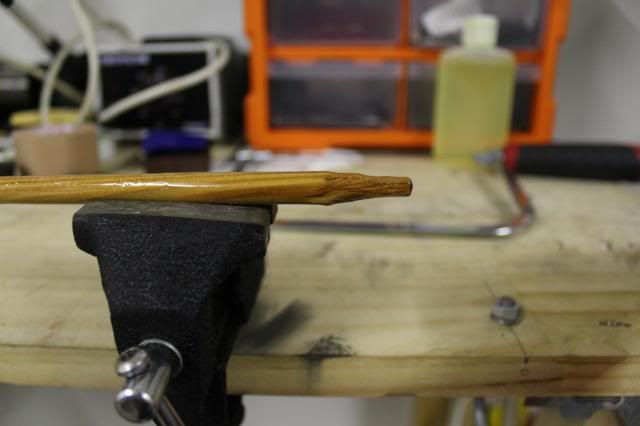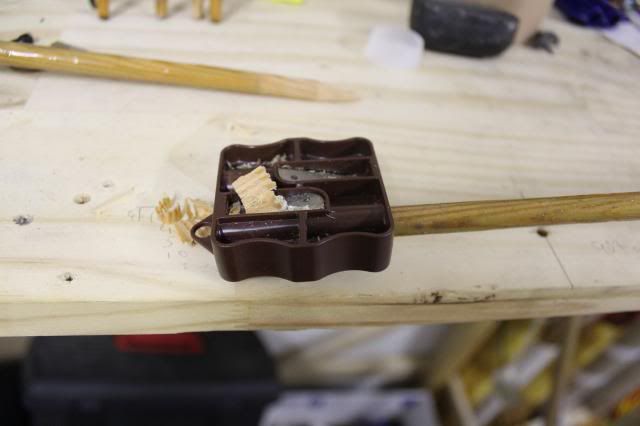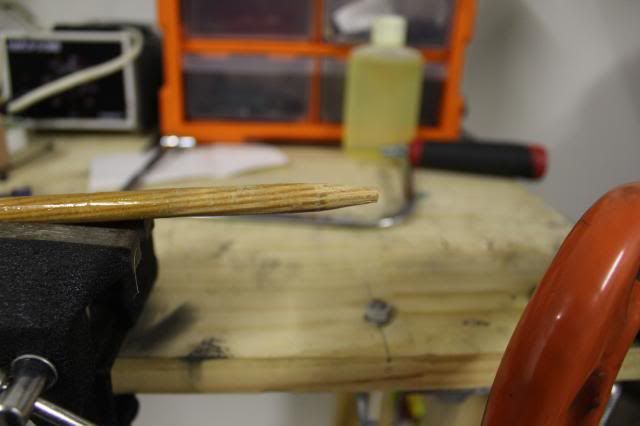Home › Forums › Friends of FOC › Att Dave Peterson
-
AuthorPosts
-
-
Dave P, and all others with input,
I want to try some woodies this fall and was wondering where to start? I have gathered Sitka spruce from Hildebrand are really good shafts to try. I am shooting a 54# recurve at 30″. I will use 300gr Tuffheads. Have you tried the 225s? Or the 190 meat heads? Are they heavy enough or is best to stay with the 300s to keep the FOC higher? Do the shafts come tapered? Is 11/32 the ones to use? Do they come straight, or do I have to do some work on them? Dave, have you had good luck with A&A fletching? How big? 4 fletch? Are you reinforcing/serving behind the head with sinew and smooth on? What do I need for cutting my tappers on the ends for both broadheads and knocks? How do I bare shaft tune woodies? Do I glue on the field points and a knock, then remove the knock and cut/re taper for reducing the length as I tune? How much does a dozen Sitka shafts cost from Hildebrand?
All insights appreciated!
Thanks,
Jans
-
JP,
Great questions. Obviously you have given this a lot of thought. Can’t wait to hear what Dave has to say! I am wondering the same thing and don’t want to purchase shafts until I have a good starting point. This year I’m hunting with a 47# 1964 Bear Grizzly at 27″ draw length and want to shoot wooden arrows. I already tuned some carbons (GT Ultralites) with 33% FOC, 600 grains but feel this bow deserves wooden arrows. I was planning on shooting tapered shafts so in the tuning process I was hoping to cut from the point end and re-taper point since cutting from nock end would shorten the 10″ taper. I know Dr. Ed’s results showed improved penetration with tapered arrows.
Steve
-
Jans — I’m afraid you’re out of luck for Sitka spruce. Given your draw weight combined with a 30″ draw you won’t be able to find shafts with enough spine to handle a 300 head and maybe not a 225. I’m not even sure Hildebrand offers shafts longer than 30″ and you would need at least 31″ for your setup. I draw 28″ and my shafts are 29″ from bottom of nock to back of point and Neil had to really scratch around to find a dozen at 85# spine for my 52# bow and 300 Tuffheads. I killed an elk with one last year but the shaft broke right behind the head. It was a bare shaft. For external footing support I have gone from 4″ of alum shafting, to SmoothOn, to winding with string or fake sinew, and now I’m going to try just 2″ of aluminum tubing. I think deer or elk sinew would make a perfect footing as it goes on my tighter, stronger and closer to the wood than string … but it would take a lot of sinew and I don’t have enough. All of Hildebrand’s shafts are super good–closely grouped for spine and weight and at least with the premium shafts I get, straight as carbon. You can order them parallel or single tapered which is 10″ tapering from 11/32 to 5/16. Price depends on so many variable you’ll need to check the website and likely give Neil a call. The 85# spine shafts weighed on average 390 grains which with the 300 head gives a near perfect (for elk) 790 or so finished arrow with right at 20% FOC, the best I’ve been able to do with wood. Any wood strong enough to give the spine you need at a 30″ draw is going to be heavy, so you’ll likely want to go down to a 225 head and your FOC will not be good. Even so I have proven to myself that a really heavy shaft with a good two-blade head can deliver pass-throughs on elk even with zippo for FOC, and that’s likely what you’re stuck with. I’ve killed elk with the 225 but not as glue-ons; rather I used them with carbons and internals that brought the head weight up to 450 for EFOC above 25$. The “sensible” thing to do given your long draw is to go with carbons in order to get EFOC and keep the total weight within reason. I have some 190 Meatheads but have not yet tried them on game. While they’re not as thick as the heavier Thunderheads, they’re as thick as many good single blades and I’m sure they’d dandy. I have never used AA fletching per se, but I do use something close: 4×3″ shield cut. There’s plenty of room for them on a tapered wood shaft or a standard diameter carbon (I use Carbon Express 350s) and as I’ve commented on other threads here, they shoot better, are totally quiet, weight a bit less and I’ve not yet been able to get them wet enough to wilt, since they’re so much smaller including not so high. When I converted I went back and stripped all the 3×5 off all my arrows and replaced them. I’m sure the AA setup is even better for well tuned arrows, but this is good enough for me since I have a feather chopper in that size. For your final question, yes, you install nocks and field points and leave the shafts full length and then cut back from the front until you hit the sweet length. With Sitka spruce this presents a problem in that the grain structure of the wood doesn’t like a razor tapering tool and when you go to resharpen the point taper after cutting back a shaft to length, it will dig gouges and do a really bad job. This is a big drawback to SS, unless you have a sander taper tool. I get round it by ordering test shafts to bare shaft testing and then ordering my shafts pre-cut to the right length and point tapered from Neil. With most wood this isn’t a problem. This is what I just did yesterday with a dozen SS I’m building for my Osage selfbow, which is a snap since it’s only about 50# draw and relatively slow so I only need 60-64 spine, which I can get at about 350 grains weight, giving me finished shafts just over 650 grains with 300 grain heads. This is not what you wanted to hear, I know, but “it is what it is.” If you decide to try some heavier woods that can handle your draw length and that heavy head, you might p.m. Kevin Forrester or google Forresterwood Arrows, who has some gorgeous but heavy hardwoods with high spine capabilities.
Steve, with your lower draw weight and shorter draw length, you should have easy sailing working up some SS shafts for 300 Tuffheads.
-
Ughhhhhh (heavy sigh), Ok Dave:), thanks for the advice. I sure did want to try some SS shafts and was hoping I could still get away with my draw length and poundage. Oh well, I will look into some of the heavier shafts and see what I can do. Sounds like you have some good setups going. I hope you can post some pics and share how they work with us!
Thanks again for taking the time to share your hard earned experience,
Jans
-
David Petersen wrote: With Sitka spruce this presents a problem in that the grain structure of the wood doesn’t like a razor tapering tool and when you go to resharpen the point taper after cutting back a shaft to length, it will dig gouges and do a really bad job. This is a big drawback to SS, unless you have a sander taper tool.
Dave I’ve had this same problem with the SS shafts I’ve been using lately. I had been using the ‘traditional only’ tool from 3rivers but I had a shaft that was a bit thick up front so put it in my Bearpaw 23/64 tool. They came out perfect. I don’t know what in all the possible variables makes the Bearpaw work, but my 11/32 SS love my 23/64 Bearpaw tool. Go figure.
Links:
Trad Only Tool:
http://www.3riversarchery.com/Traditional+Only+Taper+Tool+11%2F32_i4080X_baseitem.html
Bearpaw tool:
http://www.kustomkingarchery.com/BearPaw-Taper-Tool/productinfo/4720/
-
Thanks for the tip, Jim. And it’s dirt cheap. In fact I’ll have to order some other stuff in order to justify the postage. 😛 Fair to assume there’s no so much slop in the 23/64 that it produces an off-center taper? One limitation to all razor taper tools is that you can turn it only one direction–the way the blade faces–while many shafts have enough twist in the grain that it can cause problems. Thus an ambidextrous tool would help. Anyhow I’ll give this little guy a try. I have another dozen SS shafts on the way so will order the tool today. Thanks
-
They don’t come out off centre but the taper is a little short. It’d be worth your while getting an 11/32 bearpaw as well I reckon, in case the size doesn’t matter and there’s just something about the tool that works better.
-
Jans, here’s some pics to illustrate what we’re talking about:
A sealed shaft that had been tapered by the first tool (that the timber didn’t like):
I cut the taper off and started again on the same shaft. This is the bearpaw tool at work, making nice, clean shavings:
And the finished taper, a big improvement:
edit: FYI that shaft is not SS but produced the same results from the tools as my SS shafts.
-
-
AuthorPosts
- You must be logged in to reply to this topic.




